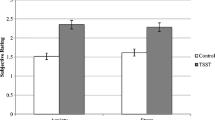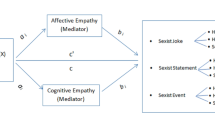Abstract
The aim of the study was to investigate sex differences in proximate mechanisms that precede the termination of conflicts. In Study 1, we asked women and men to report their intensity of anger in response to hypothetical, common transgressions involving a same-sex roommate. Direct verbal and physical aggression elicited the highest-intensity anger for both sexes, although overall women reported more intense anger than men to all transgressions. In Study 2, we examined sex differences in subjective and physiological reactions to a conflict using a role-playing scenario. Following recall of a conflict involving direct aggression and role-playing a reaction to it, compared with men, women reported their anger would dissipate less quickly and they would take longer to reconcile. Women also exhibited increased heart rate, but little change in cortisol, whereas men exhibited little change in heart rate but increased cortisol production. We interpret the results as indicating that women are less prepared than men to resolve a conflict with a same-sex peer.

Similar content being viewed by others
References
Archer, J. (2000). Sex Differences in Aggression Between Heterosexual Partners: A Meta-Analytic Review. Psychological Bulletin, 126(5), 651–680.
Archer, J. (2004). Sex Differences in Aggression in Real-World Settings: A Meta-Analytic Review. Review of General Psychology, 8(4), 291–322.
Archer, J. (2006). Cross-Cultural Differences in Physical Aggression Between Partners: A Social-Role Analysis. Personality and Social Psychology Review, 10(2), 133–153.
Aries, E. (1996). Men and women in interaction: Reconsidering the differences. New York: Oxford University Press.
Benenson, J. F., & Alavi, K. (2004). Sex Differences in children’s Investment in Same-sex Peers. Evolution and Human Behavior, 25(4), 258–266.
Benenson, J. F., & Christakos, A. (2003). The Greater Fragility of females’ Versus males’ Closest Same-sex Friendships. Child Development, 74(4), 1123–1129.
Benenson, J., Saelen, C., Markovits, H., & McCabe, S. (2008). Males Derive Greater Benefits Than Females do from Same-sex Peers Relative to Parents. Evolutionary Psychology, 6, 13–28.
Benenson, J. F., Markovits, H., Fitzgerald, C., Geoffroy, D., Flemming, J., Kahlenberg, S. M., et al. (2009). Males’ Greater Tolerance of Same-sex Peers. Psychological Science, 20(2), 184–190.
Benenson, J., Markovits, H., Hultgren, B., Nyugen, T., Bullock, G., & Wrangham, R. W. (2013). Females More Than Males Engage in Social Exclusion. PloS One, 8(2), e55851.
Blackhart, G. C., Nelson, B. C., Knowles, M. L., & Baumeister, R. F. (2009). Rejection Elicits Emotional Reactions but Neither Causes Immediate Distress nor Lowers Self-Esteem: A Meta-Analytic Review of 192 Studies on Social Exclusion. Personality and Social Psychology Review, 13(4), 269–309.
Bowles, S. (2009). Did Warfare Among Ancestral Hunter-Gatherers Affect the Evolution of Human Social Behaviors? Science, 324(5932), 1293–8.
Butovskaya, M. L. (2008). Reconciliation, Dominance and Cortisol Levels in Children and Adolescents (7–15 Year-old Boys). Behaviour, 145(11), 1557–1576.
Butovskaya, M. L., & Kozinstev, A. (1999). Aggression, Friendship, and Reconciliation in Russian Primary Schoolchildren. Aggressive Behavior, 25, 125–139.
Butovskaya, M. L., Boyko, E. Y., Selverova, N. B., & Ermakova, I. V. (2005). The Hormonal Basis of Reconciliation in Humans. Journal of Physiological Anthropology and Applied Human Science, 24(4), 333–337.
Butovskaya, M. L., Timentschik, V., & Burkova, V. N. (2007). Aggression, Conflict Resolution, Popularity, and Attitude to School in Russian Adolescents. Aggressive Behavior, 33, 170–183.
Campbell, A. (2008). Attachment, Aggression and Affiliation: The Role of Oxytocin in Female Social Behavior. Biological Psychology, 77, 1–10.
Campbell, A., & Muncer, S. (2008). Intent to Harm or Injure? Gender and the Expression of Anger. Aggressive Behavior, 34(3), 282–293.
Cisek, P., & Kalaska, J. F. (2004). Neural Correlates Ofmental Rehearsal in Dorsal Premotor Cortext. Nature, 431, 993–996.
de Waal, F. B. M. (1986). The Integration of Dominance and Social Bonding in Primates. Quarterly Review of Biology, 61, 459–479.
de Waal, F. B. M. (1989). Peacemaking among primates. Cambridge: Harvard University Press.
de Waal, F. B. M., & van Roosmalen, A. (1979). Reconciliation and Consolation Among Chimpanzees. Behavioral Ecology and Sociobiology, 5(1), 55–66.
Dickerson, S. S., & Kemeny, M. E. (2004). Acute Stressors and Cortisol Responses: A Theoretical Integration and Synthesis of Laboratory Research. Psychological Bulletin, 130(3), 355–391.
Ekman, P., Levenson, R. W., & Friesen, W. V. (1983). Autonomic Nervous System Activity Distinguishes Among Emotions. Science, 221(4616), 1208–1210.
Fernández, C., Pascual, J. C., Soler, J., Elices, M., Portella, M. J., & Fernández-Abascal, E. (2012). Physiological Responses Induced by Emotion-Eliciting Films. Applied Psychophysiology and Biofeedback, 37, 1–7.
Fine, G. A. (1980). The natural history of preadolescent male friendship groups. In H. C. Foot, A. J. Chapman, & J. R. Smith (Eds.), Friendship and social relations in children (pp. 293–320). Piscataway: Transaction Publishers.
Flinn, M. V., Ponzi, D., & Muehlenbein, M. P. (2012). Hormonal Mechanisms for Regulation of Aggression in Human Coalitions. Human Nature, 23, 68–88.
Fraser, O. N., Stahl, D., & Aureli, F. (2008). Stress Reduction Through Consolation in Chimpanzees. Proceedings of the National Academcy of Sciences, 105(25), 8557–8562.
Furuichi, T. (2011). Contribution of Female Bonobos to the Peaceful Nature of the Society. Evolutionary Anthropology, 20, 131–142.
Gabriel, S., & Gardner, W. L. (1999). Are There“his” and“ Hers” Types of Interdependence? The Implications of Gender Differences in Collective Versus Relational Interdependence for Affect, Behavior, and Cognition. Journal of Personality Social Psychology, 77(3), 642–655.
Goodall, J. (1986). The chimpanzees of Gombe: Patterns of behavior. Cambridge: Harvard University Press.
Hohmann, G., & Fruth, B. (2000). Use and Function of Genital Contacts Among Female Bonobos. Animal Behaviour, 60(1), 107–120.
Jamieson, J. P., Koslov, K., Nock, M. K., & Mendes, W. B. (2013). Experiencing Discrimination Increases Risk Taking. Psychological Science, 24, 131–139.
Kirschbaum, C., Kudielka, B., Gaab, J., Schommer, N. C., & Hellhammer, D. H. (1999). Impact of Gender, Menstrual Cycle Phase, and Oral Contraceptives on the Activity of the Hypothalamus-Pituitary-Adrenal Axis. Psychosomatic Medicine, 51, 154–162.
Kon, I. S., & Losenkov, V. A. (1978). Friendship in Adolescence: Values and Behavior. Journal of Marriage and the Family, 40, 143–155.
Kudielka, B. M., & Kirschbaum, C. (2005). Sex Differences in HPA Axis Responses to Stress: A Review. Biological Psychology, 69(1), 113–132.
Kudielka, B. M., Buske-Kirschbaum, A., Hellhammer, D. H., & Kirschbaum, C. (2004). HPA Axis Responses to Laboratory Psychosocial Stress in Healthy Elderly Adults, Younger Adults, and Children: Impact of age and Gender. Psychoneuroendocrinology, 29(1), 83–98.
Langergraber, K., Mitani, J., & Vigilant, L. (2009). Kinship and Social Bonds in Female Chimpanzees (Pan troglodytes). American Journal of Primatology, 71(10), 840–851.
Lehmann, J., & Boesch, C. (2009). Sociality of the Dispersing sex: The Nature of Social Bonds in West African Female Chimpanzees, Pan troglodytes. Animal Behavior, 77(2), 377–387.
Lever, J. (1978). Sex Differences in the Complexity of children’s Play and Games. American Sociological Review, 43(4), 471–483.
MacEvoy, J. P., & Asher, S. R. (2012). When Friends Disappoint: Boys’ and girls’ Responses to Transgressions of Friendship Expectations. Child Development, 83, 104–119.
Markovits, H., Benenson, J., & Dolenszky, E. (2001). Evidence That Children and Adolescents Have Internal Models of Peer Interactions That are Gender Differentiated. Child Development, 72(3), 879–886.
Palagi, E., Paoli, T., & Tarli, S. B. (2004). Reconciliation and Consolation in Captive Bonobos (Pan paniscus). American Journal of Primatology, 62(1), 15–30.
Porges, S. W. (2011). The polyvagal theory: Neurophysiological foundations of emotions, attachment, communication, and self-regulation. New York: WW Norton.
Romero, T., Castellanos, M. A., & de Waal, F. B. M. (2010). Consolation as Possible Expression of Sympathy Among Chimpanzees. Proccedings of the National Academcy of Sciences, 107, 12110–12115.
Sapolsky, R. M., Romero, L. M., & Munck, A. U. (2000). How do Glucocorticoids Influence Stress Responses? Integrating Permissive, Suppressive, Stimulatory, and Preparative Actions. Endocrine Reviews, 21, 55–89.
Savin-Williams, R. C. (1980). Social interactions of adolescent females in natural groups. In H. C. Foot, A. J. Chapman, & J. R. Smith (Eds.), Friendship and social relations in children (pp. 343–363). New Brunswick: Transaction.
Schlegel, A., & Barry, H. (1991). Adolescence. New York: The Free Press.
Schumann, K., & Ross, M. (2010). Why Women Apologize More Than men. Psychological Science, 21(11), 1649–1655.
Sell, A. N. (2011). The Recalibrational Theory and Violent Anger. Aggression and Violent Behavior, 16, 381–389.
Sell, A. N., Tooby, J., & Cosmides, L. (2009). Formidability and the Logic of Human Anger. Proceedings of the National Academy of Sciences, 106, 15073–15078.
Stroud, L. R., Salovey, P., & Epel, E. S. (2002). Sex Differences in Stress Responses: Social Rejection Versus Achievement Stress. Biological Psychiatry, 52(4), 318–327.
Taylor, S. E., Klein, L. C., Lewis, B. P., Gruenewald, T. L., Gurung, R. A. R., & Updegraff, J. A. (2000). Biobehavioral Responses to Stress in Females: Tend-and-Befriend, not Fight-or-Flight. Psychological Review, 107(3), 411–429.
Tiger, L. (1969). Men in groups. New York: Random House.
Trivers, R. (1972). Parental investment and sexual selection. In B. Campbell (Ed.), Sexual selection and the descent of man (pp. 136–179). Chicago: Aldine Publishing Company.
Watts, D. P. (2006). Conflict Resolution in Chimpanzees and the Valuable-Relationships Hypothesis. International Journal of Primatology, 27(5), 1337–1364.
Whitesell, N. R., & Harter, S. (1996). The Interpersonal Context of Emotion: Anger With Close Friends and Classmates. Child Development, 67(4), 1345–1359.
Winstead, B., & Griffin, J. (2001). Friendship styles. In J. Worell (Ed.), Encyclopedia of women and gender (pp. 481–492). Boston: Academic.
Wittig, R. M., & Boesch, C. (2003). The Choice of Post-Conflict Interactions in Wild Chimpanzees (Pan troglodytes). Behaviour, 140, 1527–1559.
Wrangham, R. W. (1999). Evolution of Coalitionary Killing. Yearbook of Physical Anthropology, 29(42), 1–30.
Wrangham, R. W. (2000). Why are male chimpanzees more gregarious than mothers? A scramble competition hypothesis. In P. M. Kappeler (Ed.), Primate males (pp. 248–258). Cambridge: Cambridge University Press.
Acknowledgments
The authors thank Emmanuel College, Harvard University, and the University of New Mexico for support of this project.
Author information
Authors and Affiliations
Corresponding author
Rights and permissions
About this article
Cite this article
Benenson, J.F., Kuhn, M.N., Ryan, P.J. et al. Human Males Appear More Prepared Than Females to Resolve Conflicts with Same-Sex Peers. Hum Nat 25, 251–268 (2014). https://doi.org/10.1007/s12110-014-9198-z
Published:
Issue Date:
DOI: https://doi.org/10.1007/s12110-014-9198-z




